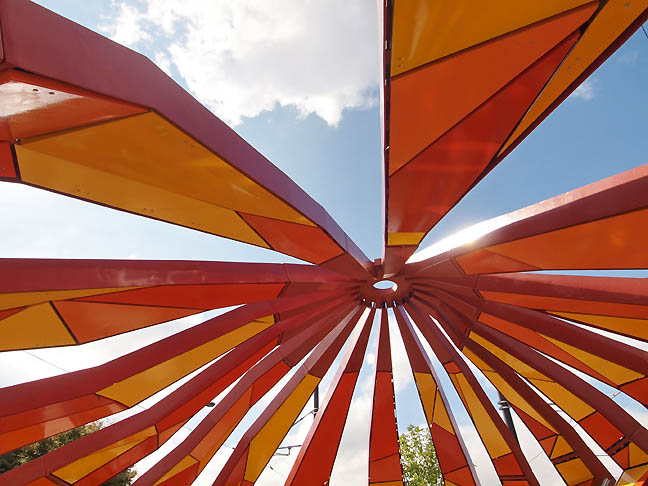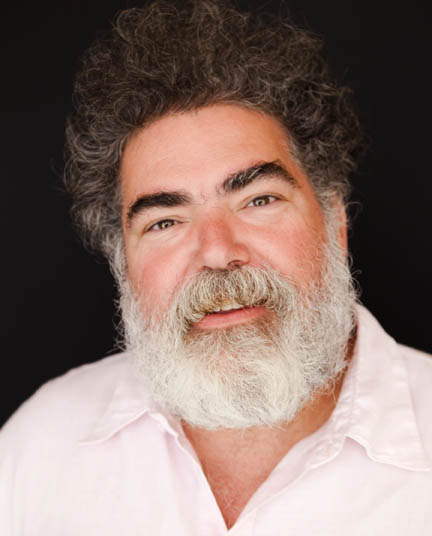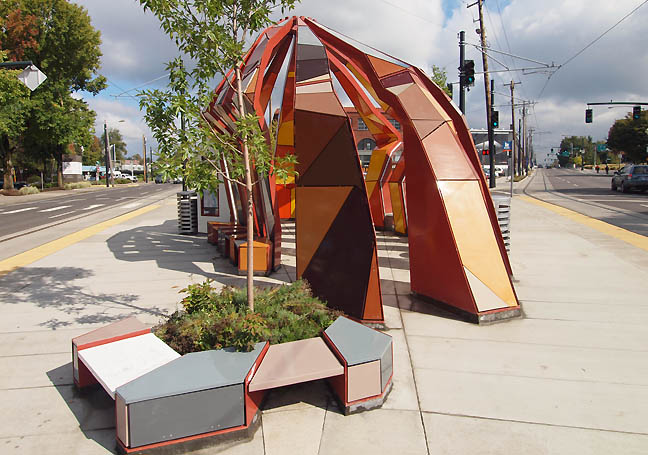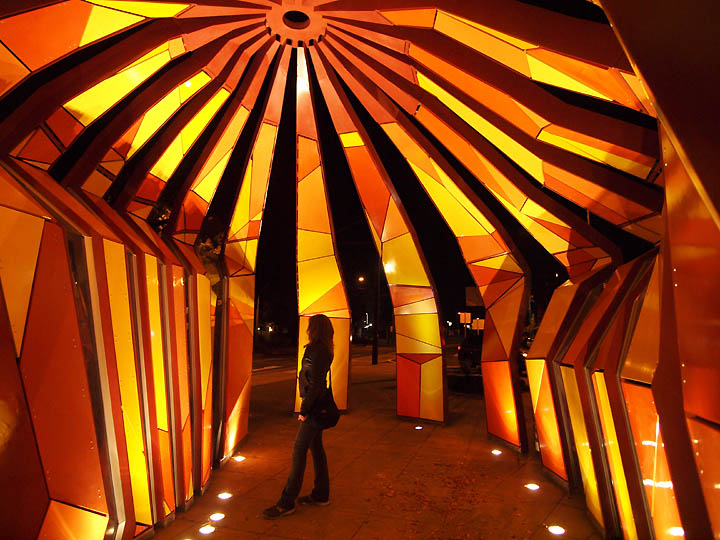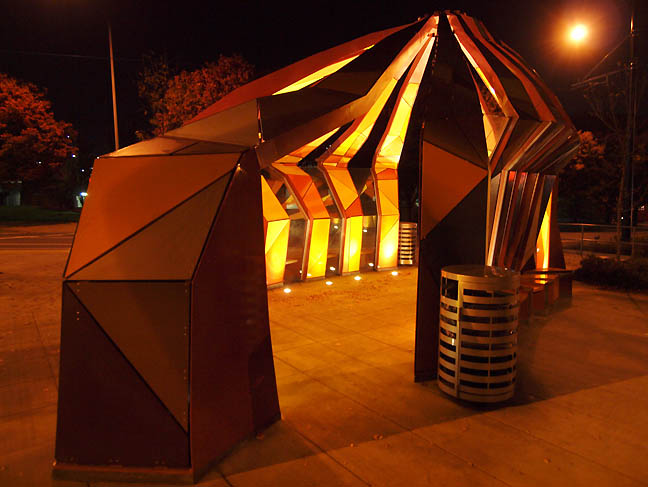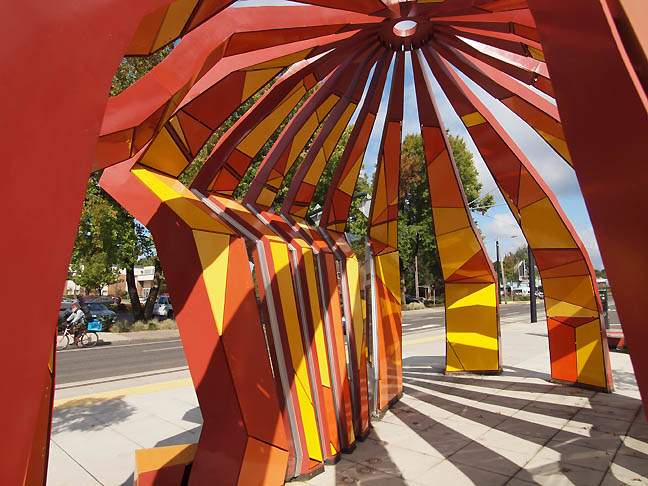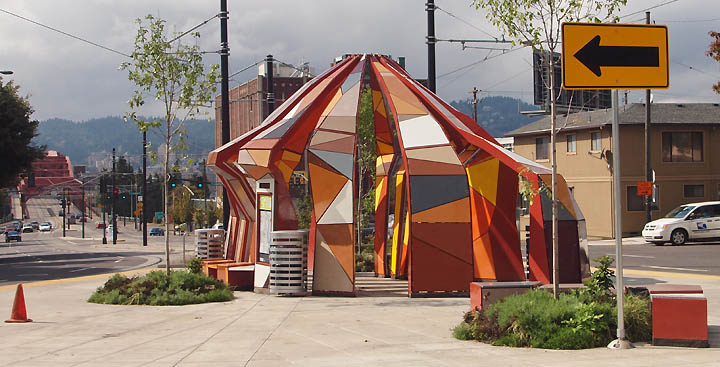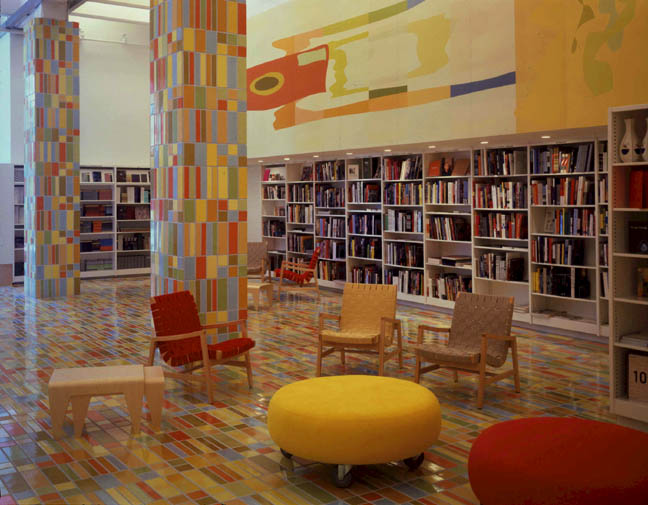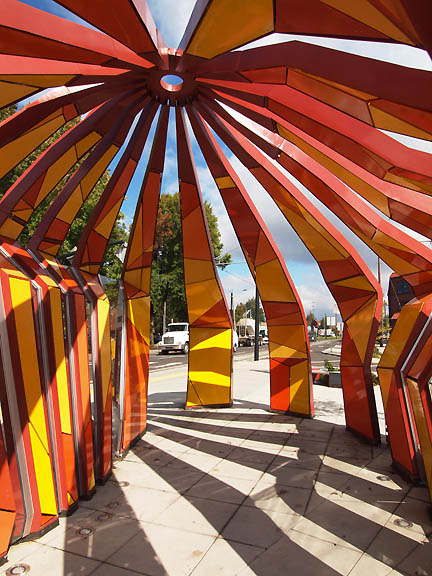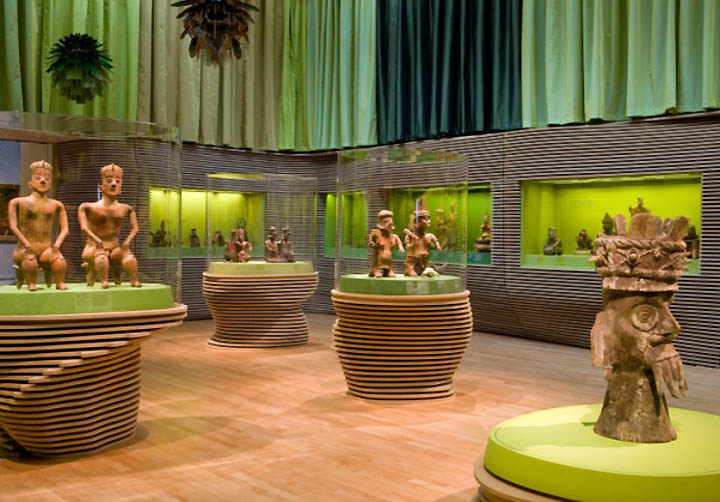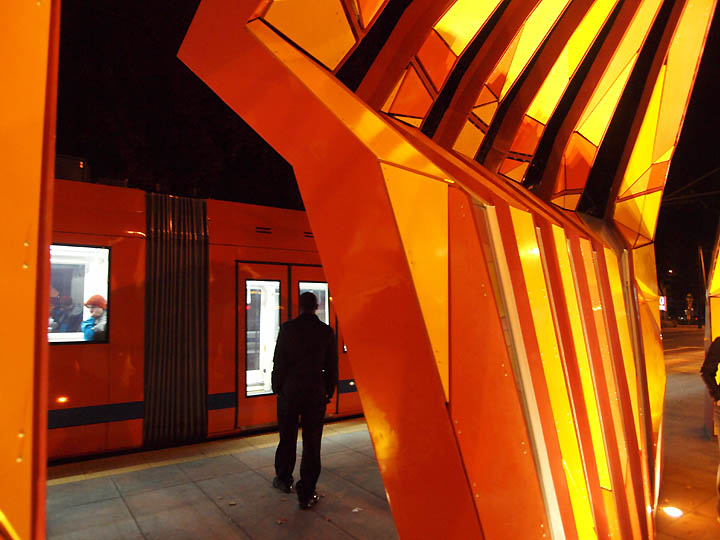
|
||
|
Portland art blog + news + exhibition reviews + galleries + contemporary northwest art
|
||
Interview with Jorge Pardo
Jorge Pardo's work raises questions about the artificial separation of art, design, architecture and the orthodoxies that shape the way we consume all of them as cultural products. For his 1998 exhibition at MOCA he paradoxically shifted the site from the museum to a home at 4166 Sea View Lane, which he had built for the exhibition. Afterwards he moved in, upending the entire patron/institution/artist dynamic. He now has a similar, but more extensive project in the Yucatan called Tecoh. Rather than simply show in white box galleries he has even created installations that function as lighting for restaurants. In person he's informal but intensely inquisitive, for example before we started the interview he wanted to know a great deal about the Portland's art scene and the way artists live here. In 2010 he was awarded a MacArthur fellowship. In 2008 he was commissioned to reinstall LACMA's pre-Columbian galleries but for PORT he came to speak about his Station for Portland Streetcar, commissioned by the Regional Arts and Culture Council (RACC). I would argue that it is perhaps the most successfully beguiling piece of public art in the city's history, and it impresses like no other piece installed outdoors within the Portland (or Seattle) city limits over the past decade or so. In short, it ups the ante.
Jeff Jahn: You are originally from Cuba? Jorge Pardo: Yes I was originally born in Cuba and my family emigrated to Chicago in 1969. I was six so it is where I spent most of my life as a child. I pretty much grew up there. I went to high school then I went to the University of Illinois. Then I left Chicago in 83 and Ive been in LA till really... about forever. I now have a studio in Mexico as well so I'm not in LA like I used to be but I've spent 30 years there. J: Typically public art in Portland is more quirky than challenging. Yet you do things at such an incredibly high level so one question has to be, how did you come to this project for Portland? P: They (RACC) were looking for artists for these three sites, the other two sites were by another team. It was a competition of some sorts. I came up and presented. They were very straight forward and nice. They gave us a project and we did a proposal. That was 2-3 years ago but I had no relationship with the city really. It was the first time I had ever came up, when I presented. That was it really. I don't really do a lot of civic stuff in the United States.
J: This is your first civic commission in the United States isn't it? P: Yeah, I mean "public" projects in the United States. There have been many quasi-public things that were from the private sector for individual collectors. Many more of the public things that I have done are in Europe. J: This project it is an interesting, or should I say challenging site bounded on all sides by heavily used roads. It gets a heavy amount of uses when there are events at the Rose Garden arena (Moda Center). The rest of the time it is...
P: Kind of a weird island J: How did you approach it? P: Well it is a triangle and it is bordered on all sides by streets. It is pretty much the first stop you reach after you leave or enter the downtown area on the other side of the river (the Pearl District). So it is right after the bridge (Broadway). The site was already structured like a funnel and I just assumed it was something that was going to be used periodically like you said. So it is kinda dead and then when there are games it is full of people and I thought of it as more of a sculpture right before you cross a bridge or when you enter another neighborhood. It seemed like a good site in that sense. It isn't someplace you just pass by on the road, it is more like a gateway. J: It is a prompt. People take note of it constantly, whether they are sensitive to art or not and they ask me, "What is it?" "What is going on there?" You have people talking.
P: Because as a gateway it is already structured for you in a kind of a positive or interesting way, so you don't have to call people to it. It is already present in a way that is really clear. So I just focused on what is it going to do? Optically what is going to happen? I wanted something that worked from a distance that seemed like an interesting place to sit and visit or simply walk by. It has got sort of a quasi interior but not really. The interior is really there so it can be lit at night.
J: So it is a lantern, which you are also known for? P: Yeah, how do you turn a building into a lantern. It isn't really a building, instead it is more of a stop for pedestrians and the streetcar. It is very simple and it isn't even that much of an idea but I took photos of beautiful days like today, which from what I understand are in short supply. J: for 5-8 months of the year it rains constantly, usually it is about 6. It can break people. P: So depending on the year the sun becomes something in short supply and the idea was basically how do you use the weather to work with color? So we took a bunch of photographs and when we digitized them there were about 10 colors that came out. So we started to separate them and those are the ones on the outside. For the inside I took a single image of a typical sunny day in Southern California right in the area around where I live and did the same process to those colors. They came out and I just tried to optimize them for when they would be lit at night. I kind liked the idea of a structure that aspired to be like the Sun at night.
J: It is faceted and jewel like at the same time but the lantern like aspect even comes through during the day. P: You can be in it, or out of it. It is there to attract you. It is also there to mark the place. That was something to bring forth because it isn't just a tram stop it is a place that acts as a meeting point. It becomes a part of the city that way somehow in that you can rendezvous and therefore integrate the site. That was an important aspiration. It had to be optically dynamic enough to charge the site. J: It becomes like a filter or turbine that the flow of people move through. The lantern aspect reminds me of Capital buildings with domes that are often lit at night... only on a more human scale. When I was doing research for a Judd exhibition and conference a few years ago I came across a term he adapted from Joseph Albers called a manifold spatial construction... basically a sieve like structure that lets filters the universe or at least light as time passes through it. The first time I saw your piece I thought, manifold spatial construction. P: I'm not so much of a colorist like Albers in that way. I work with pallet. For example there are certain combinations that make it difficult for people to walk by them unnoticed. In many ways it has something to do with the proximity. This whole idea of how do you make a counterpoint to what it is normally like here pallet wise and give it a structure that becomes an organizing principle for color for the piece?
J: Did you consider the Broadway Bridge, it is painted the same color as the Golden Gate Bridge, which reads as a somewhat related red to the tints you used? P: It was nearby so I thought about the bridge, but to be honest it isn't so much about speaking to the bridge other than obviously that it is there and the bridge is part of the gateway effect. It is a different city when you are on one side of the river than the other. I thought about those types of generalities but the structure wasn't really taken from or in conversation with the bridge even though it has a lot of steel in it. J: I think that works, your work is clearly a separate design language and isn't mimicking anything structural from the bridge. But the form of this project itself is related to your earlier works. You've done numerous large lantern like installations that grew out of an earlier use of arrays of smaller actual lanterns in spaces like restaurants. All had a lot of modular pieces and clearly this Portland work has that but this piece is far less symmetrical than the earlier lanterns. How did you arrive at that as a form? P: You know I draw on the computer all of the time. I have two CNC machines and lasers. I have had a digital studio for a long time, 20 years. I just started drawing and ended up designing something that would actually provoke one to have a reason for going around it. If you look at one side it is actually quite long. If you are coming at it after going over the bridge its aspect is quite narrow. It has a nice dynamic depending on which side you are approaching it from because it is different from each side. It was designed as an object that was trying to be conscious of it changing as you move through it. J: It sites itself depending on what side you approach it from. P: Exactly, but it also compresses itself and expands itself. It is hard to really see that from the top and it doesn't necessary make itself all that clear, well it does a bit, but when you approach it it kind of constricts pretty intensely then it opens up... then it closes again. These are really kinda basic formal concerns that the work gets designed with. J: So the geometric or crystalline construction was just the language you were working with at the time? P: Yes but it was also about how do I deploy color... by using facets. How do I set up an optical field and charge it with as much variety as you can given 10 colors. So what you do is you start to move those facets. You can have 10 yellows but because it is at this angle it becomes an infinite amount of yellows and oranges. So I was thinking how to do that with a certain kind of efficiency. J: That makes perfect sense to me... I know over the years people have asked, is this art or is it architecture? Many will confuse the overall purpose of the structure as shelter first since that is typically what you find at light rail stops. P: It is sculpture for me because that is where I come from. I wasn't trained as an architect but I became very interested in it. I feel like if you play out sculpture to what it has become it is about places and people and movement, which are all things that are very straight forward. The question is very interesting to me because it isn't the object but how you approach the object, how do you consume the object? And just as important is how do you take it with you when you leave? Is the doorknob more important than the wall? You are kind of gestalting the building then you go inside. I just became very interested in how that behavior effects and constitutes an art experience. J: That discussion of use and observing/prompting use is crucial I think. One of the first projects I saw in person of yours was what you did to the Dia foundation's original Chelsea space and the fantastic tile colors you covered the space with. I wasn't accustomed to seeing those particular colors of tile in that profusion and in consort frankly. Especially when I go to New York. What lead you to choose tile for that particular project. P: Well I had been working in Mexico and I had a relationship with this gentleman who had a company. We were making work together... he was fabricating things for me. Tile historically is one of the most traditional ways of creating a durable surface. But tile isn't often used in that size and kind of a space and tile is also a great way to deploy color with. And the Dia had this tradition of a really austere aesthetic which meant, "seriousness." I wanted to offset and play with that? What happens when you make a work that doesn't require that strategy to be present? How do you make a work that operates with a different type of play to work? Also, tile is different than paint because tile has a kind of materiality that you feel differently. All the things that institutions try to imbue in themselves in other ways. I was thinking about Judd and the way it tries to shut down the quality of the space, it is almost musical in a way. And I wanted to do something similar but from a totally different realm. J: It is as if the faceting of the tile amplifies your work. Judd is quiet and slow music. Yours is, well intentionally loud. P: Right, it was not not from the trajectory of austerity or anything like that but from the point of view of excess or something like that. Which is different. In Judd's work he goes to Marfa because there is too much going on in New York where things cant be centralized and focused and perceived and consumed with enough silence. Then he finds this place in the world that has so much silence. Then of course it becomes this other thing. I think about it much more differently. I'm thinking about how do you make things much more carnivalesque? The conditions of the object really are about the effect and not just an object itself. J: I hadn't really thought of it before but your piece is very harlequinesque with its facets and color. Picasso was obsessed with it and returned to the motif again and again. Your piece has all of these interlocking triangles. P: It has tiny little shapes and again there aren't that many colors used but because of the nature of the motion of the geometry, which makes it appear like much more is going on than there
J: A festival? P: It is festive it is moving it is kind of funny it is strange. It is trying to play with seriousness in a completely different way and I like that. I went to school in the 1980's when it was all proto conceptual bullshit and I'm very well trained and versed in all that but at the end of the I was concerned with how do you develop a practice that is primarily visual again? With a lot of consideration in terms of context. J: You embrace context differently than the modernists and post modernists. It seems like your practice isn't as monomaniacal in that it has to be the only art object or authority in the room. In fact it foregrounds porous accessibility and layers of program. For example the project you did with LACMA in that you contextualized all of those artifacts. But also for Portland it is drawing things in. It isn't diminished as art by being seating or a stop for light rail and having an applied context. It isn't separated from the world. P: It has got a lot of stuff going on around it. It has traffic on all sides, it has the streetcar. It takes on this ritual after the basketball games. It has all of these things that don't make it pure. It is really a site, a place and it is a marker. It is not a thing. Judds are things and I love Marfa. But when you go there you really experience the work and consume the infinite variation of the differences. You go into the space with all of the aluminum boxes and you go, "oh my god this is atonal music." It its happening in this solidified form so it needs a certain amount of silence. It is really beautiful because you can see the light coming in and it is a big deal that this box has a different interior than the one next to it. They are objects that speak individually but they kinda need each other. I don't feel most people understand Judd's work because they see one thing. They don't see it as a circuit of events. J: I like to think of Judds as musical instruments that are played by the eyes, viewing them is like plucking a string and theu resonate. But instead of sound, looking at it creates space. Because the character of the space already exists the ambient volume of that spatial character has to be ratcheted down so everything becomes equally important... or at least doesn't take precedence. In your work the streetcar visits, people arrive and leave. Instead of racheting down the ambient noise of the place it amplifies. It is a lantern of navigation and it plays host and puts on a show. It does seem to have relationship to music but perhaps that's just the history of musical and notation being visual. Did you ever get into Paul Klee's Pedagogical Sketchbook? His famous notes on the possibilities of line and color with a lot of relationships to sound? P: I don't think about them directly but I am interested in referencing things like the history of painting. Originally when I started as a painter I thought that taking painterly space and then turning it into 3D was much too simple. But I do think about opticality as a kind of optic to look at other things with and how do you do that in real time? Not just the space but how do you move through something like that? For example the brightest iteration of the Portland piece is at night. It is this thing that aspires to create this very intense zone of light and it happens in the rain or after the sun goes down. For example, when is raining there is water coming through and it is very bright and everything sort of disappears. It does a lot of funny things that kind of contradict themselves. I like that, I like things that are kinda hard to martial into some kind of logical order. J: Early on it seemed like everyone was trying to categorize what you do as a discipline like designer. It is a testament to your methodology of exploring contradictions that they couldn't label you a rogue architect or neo modernist. I appreciated that about the work. Obviously you have a lot of different interests is there any particular music you do listen to? P: Interestingly enough I mainly just listen to whatever my daughter listens to. I like music but I don't necessarily correlate what I do to it. It isn't something I use to make work. Though I like the history of it and kinda enjoy enjoy thinking about it structurally. Actually, I like structure in general a lot. I like to think about how things are put together. For me the moment things happen are when you understand how the structure of a thing makes it what it is. And if there is generally a way to characterize what I'm doing by putting things together then generally that is when I'm doing a good job. For example you mentioned the piece at LACMA. The interesting thing about that project was I was asked to sort of present this other work. I was asked to create an optic for how you consume that particular material they wanted to display. Generally when people do that they do it in a way that is about privileging these objects in ways that almost make no sense to me. Normally when you see deeply historical object that are normally put on display in museums, which are hundreds or thousands of years old there is a kind of extreme deferential position that is taken. You put it in the vitrine and you have a little card that tells you what it is and usually the lights are low and you go from one to one and the problem is you end up not really looking at something, you end up reading about the work which keeps you from really consuming the work. In working on that project I looked at each thing individually and realized that there is a lot stuff going on in those objects that has to do with how somebody was thinking when they made it. There is a lot of color and material decisions. A lot of attention paid to the front and to the back. Those are all things that are somewhat impossible to put forth when you are putting it in the remnant of a 19th century vitrine.
J: and that object was perhaps never intended as an incredibly important object and instead was just a utilitarian basket. P: But that basket might have three very beautiful greens in it but somehow that optical information isn't really fore fronted in a way. I was really interested in the way these people who made this object long ago really aren’t that different than I am when I'm making this object to show their object in. We are both playing this formal game, only in different times. So I wanted to use those things and play with those things and talk about what they were doing optically as a thing in the world now.
P: Do you live in proximity to it? J: Close enough that I could technically walk to it or use the max to take me to the streetcar. P: Because people take a lot of public transportation here? J: Yeah, I took a train to meet you today. P: It it is easier to come into the downtown that way, you don't have to worry about parking. J: It is a great thing. What I like is the way the streetcars come right up to your piece, kinda like caterpillars and your structure is a chrysalis that something like a monarch butterfly is splitting open and emerging from. Its good from the street but its excellent to explore. I think people are going to be surprised. There are a lot of different ways to look at it. P: It is such a nice city. It feels like a proper European city. It is properly put together. Things work... Posted by Jeff Jahn on October 23, 2013 at 0:47 | Comments (0) Comments Post a comment Thanks for signing in, . Now you can comment. (sign out)
(If you haven't left a comment here before, you may need to be approved by
the site owner before your comment will appear. Until then, it won't appear
on the entry. Thanks for waiting.)
|
| s p o n s o r s |
 |
 |
 |
 |
 |
 |
 |
 |
 |
 |
 |
 |
 |
 |

|
Site Design: Jennifer Armbrust | • | Site Development: Philippe Blanc & Katherine Bovee | |


